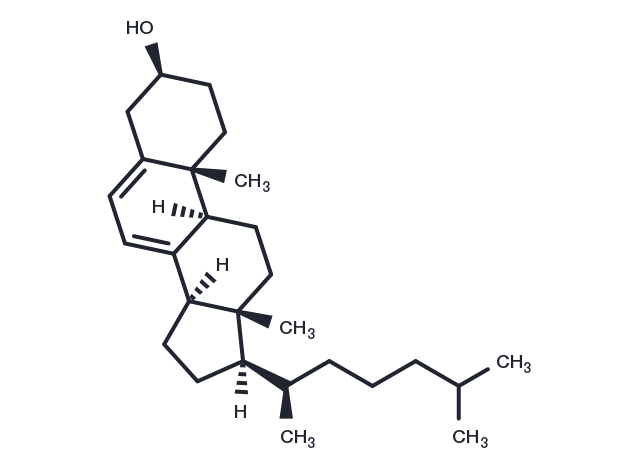Powder: -20°C for 3 years | In solvent: -80°C for 1 year


7-Dehydrocholesterol (Provitamin D3) down-regulates cholesterol biosynthesis in cultured Smith-Lemi-Opitz syndrome skin fibroblasts.

| Pack Size | Availability | Price/USD | Quantity |
|---|---|---|---|
| 50 mg | In stock | $ 33.00 | |
| 100 mg | In stock | $ 47.00 | |
| 500 mg | In stock | $ 112.00 | |
| 1 mL * 10 mM (in DMSO) | In stock | $ 39.00 |


| Description | 7-Dehydrocholesterol (Provitamin D3) down-regulates cholesterol biosynthesis in cultured Smith-Lemi-Opitz syndrome skin fibroblasts. |
| In vitro | 7-Dehydrocholesterol is a biosynthetic precursor of cholesterol and vitamin D3. 7-Dehydrocholesterol is present in relatively high concentration in skin where it is converted to pre-vitamin D3 upon UV irradiation and where it is also exposed to exogenous radical sources and oxygen. |
| Synonyms | Provitamin D3, 7-DHC |
| Molecular Weight | 384.64 |
| Formula | C27H44O |
| CAS No. | 434-16-2 |
Powder: -20°C for 3 years | In solvent: -80°C for 1 year
DMSO: 11 mg/mL (28.6 mM)
You can also refer to dose conversion for different animals. More
bottom
Please see Inhibitor Handling Instructions for more frequently ask questions. Topics include: how to prepare stock solutions, how to store products, and cautions on cell-based assays & animal experiments, etc.
7-Dehydrocholesterol 434-16-2 Metabolism Endogenous Metabolite 7 Dehydrocholesterol Inhibitor Provitamin D3 7-DHC 7Dehydrocholesterol inhibit inhibitor
